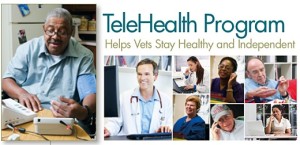 “Telehealth isn’t about seeing a provider by video: it’s about decision making,” Dr. Adam Darkins, leader of the U.S. Department of Veterans Affairs National Telehealth Programs, told the audience in his keynote address at the Government Health IT Conference in Washington, DC, on June 17, 2014.
“Telehealth isn’t about seeing a provider by video: it’s about decision making,” Dr. Adam Darkins, leader of the U.S. Department of Veterans Affairs National Telehealth Programs, told the audience in his keynote address at the Government Health IT Conference in Washington, DC, on June 17, 2014.
Dr. Darkins, trained as a neurosurgeon, realized earlier in his career “time and again,” he said, that he should have seen his patients more frequently in-between face-to-face visits. “A good decision downstream can make a lot of difference to someone’s longevity,” Dr. Darkins recognized.
He’s worked with a team at the VA to build several flavors of telehealth to deliver care to veterans. The VA has adopted telehealth based on the strong business case of reducing bed days of care and hospital admissions which result in hard dollar savings—and better care for patients.
In 2014, the VA uses six forms of telehealth:
• Clinical video telehealth
• Home telehealth
• Store and forward
• Teleradiology
• Secure messaging
• Mobile health.
While the concept of telehealth means many things to many people, he believes the definition is evolving. One day, Dr. Darkins anticipates, “telehealth” will be the way all health care will be provided. “We won’t call it anything but ‘health care.’”
He noted that one telehealth mode has been around for over 100 years – the use of the telephone. Now none of us would dream of doing healthcare without using the telephone, Dr. Darkins said.
In FY2013, telehealth played a fundamental role in the VA’s delivery of health care to veterans. Telehealth was used by 151 VA Medical Centers and over 705 Community Based Outpatient Clinics for 608,900 patients, generating 1.8 mm telehealth episodes of care. 45% of these patients lived in rural areas. Telemental health is particularly fast-growing via many platforms, including mobile phones and tablets. And, the number of veterans receiving telehealth services is expanding 22% annually. In FY2013, 11% of veterans were served by a VA telehealth program.
The vision for telehealth in the VA is to support a patient focus, making the home or local community the preferred site of care – the right care in the right place at the right time. As Dr. Darkins saw earlier in his neurosurgery career, telehealth helps coordinate care across the continuum. Telehealth also enables patient self-management and shared decision making, using patient-facing techs to capture routine activity and outcomes data.
The VA can provide telehealth services to patients nationally because in the VA, if a doctor is licensed in one state to practice medicine, he/she can practice telehealth nationally. That’s an important regulatory barrier the VA has overcome; a second technical barrier the Agency has leapfrogged is that providers across the nation can use an interconnection via a direct dial internet protocol connection in a national dial plan from one center to another to do telehealth.
The VA’s telehealth program yields a strong business case: in FY2013, the VA’s home telehealth program reduced bed-days by 59% and hospital admissions by 35%. Telehealth in the VA also experienced high mean scores for patient satisfaction. And, home telehealth savings were $1,999 per patient per year.
There remain some challenges to deal with in the VA telehealth program, Dr. Darkins admitted: “this isn’t taught in medical school,” he observed, and there’s a blurring of biomedical devices and health IT that can sometimes make roles also potentially conflicting or confusing. The Joint Commission doesn’t survey telehealth, so the VA self-monitors and sticks to standards and quality measures to stay on-track.
Health Populi’s Hot Points: With the VA health delivery system under fire for quite legitimate reasons, it’s also important to recognize the institution for its innovations. Two of these are telehealth, discussed here; and also the VA’s electronic health records innovations, including My HealtheVet, the VA’s personal health record for veteran-patients.
The scale of the VA and its closed nature has allowed it to innovate for a large number of patients, in some respects like a Kaiser or Geisinger have. Dr. Darkins and the VA telehealth team have pioneered the concept and demonstrated the business case for delivering health care, asynchronously and synchronously, to people at home and more conveniently in their communities. The private sector would do well to learn from the VA’s successful development and deployment of telehealth solutions.




 Thank you FeedSpot for
Thank you FeedSpot for